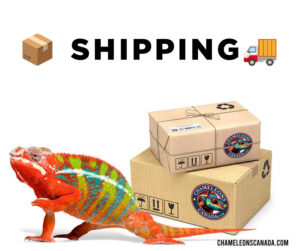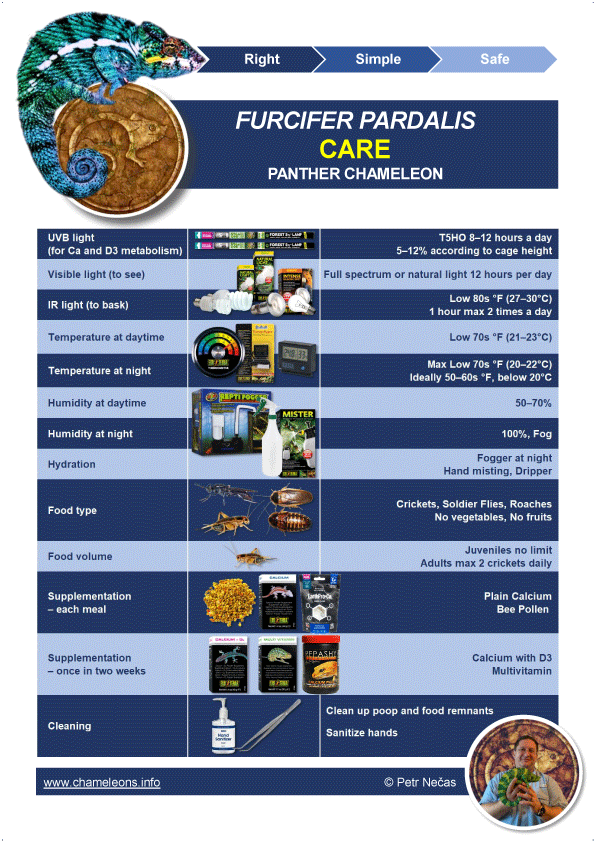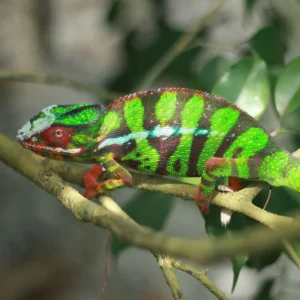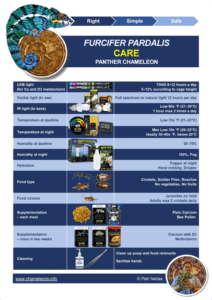

Article by Petr Necas & Bill Strand (Download the Quick Guide as a PDF)
Legend | Sub-legend | Description |
Taxonomy | Taxon | Furcifer pardalis |
Common Names | Panther Chameleon (English) Sakorikita (Malagassy) | |
Original name | Chamaeleo pardalis | |
Author | Cuvier, 1829 | |
Original description | Règne, animal, 2nd ed., 2: 60 | |
Type locality | Ile de France (= Mauritius, erroneous), restricted to Madagascar | |
Typus | HNP 6520 | |
Taxonomy | A formally monotypic species with no recognized subspecies, however, recent studies reveal many (4 big, up to 11) entities within this species, defined geographically, that show a different level of relativeness, some so distant from each other to be possibly considered a separate species and/or subspecies. Historically, many synonyms were introduced, such as Chamaeleo ater, niger, guentheri, longicauda, axillaris, krempfi. The term “locale” is used in captive management only; it has no taxonomic relevance and refers to the distinct subpopulations named usually after a village within its (often not isolated and well defined) range, differing from each other through unique colouration and patterns, mainly males. The distinguished “locales” are as follows: Ambanja, Ambilobe, Ampitabe, Androngombe, Ankaramy, Ankarana (E and W), Andapa, Anki- fy, Antalaha, Antsiranana (Diego Suarez), Beramanja, Cap Est, Djangoa, Fenoarivo, Mahavelona, Mangaoka, Manambato, Mananara, Maroantsetra, Marojejy, Nosy Be, Nosy Boraha, Nosy Faly, Nosy Mangabe, Nosy Mitsio, Sambava, Sambirano, Soanier- ana Ivongo, Toamasina (Tamatave), Vohimana. Captive projects include often deliberate crossbreeding of “locales” that lead to genetically unidentifiable animals and should be omitted. Member of the genus Furcifer. |
Legend | Sub-legend | Description |
Life Space |
Range | Distributed along NE, N, NW and E coast of Madagascar, south reaching the vicinity of Tamatave, including many offshore islands (e.g. Nosy Be, Nosy Boraha, Nosy Faly, Nosy Mangabe, Nosy Mitsio…). Introduced in Madagascar at Andasibe, long ago in Reunion and Mauritius (populations might be even originating from drifted single specimens, not man-induced) and recently in the USA (Florida). |
Altitude | 0 – 950m a.s.l., typically in lowland coastal areas | |
Macro-habitat | Tropical dry forests and agricultural land incl. heavily disturbed habitats | |
Micro-habitat | Trees and shrubs, living fences, agricultural plants. | |
Perching Height | 0–10m above ground (babies in grass and low bushes, semi-adults in bushes, adults in trees and bushes). In forests (rarely) in the canopies of trees | |
Daily Activity | A whole day in the shade of big trees, Morning and late afternoon 1-2 hour basking on a sun-exposed branch, Sleeping within bushes and canopies of trees, In case of rain hiding in the middle of bushes or in tree canopies close to stems | |
IUCN Status | Not specifically protected. Exported from Madagascar yearly in hundreds to thousands of specimens without visible impact on native populations; protected through difficult accessibility or restricted traffic on remote areas and islands. | |
Conservation | Living in many protected areas, including Réserve Naturelle Intégrale de Lokobe, Réserve Spéciale de Manongarivo, Réserve Spéciale d’Ambatovaky, Parc National de Marojejy, Réserve Spéciale de Nosy Mangabe, Parc National de Zahamena and Parc National de Sahamalaza. | |
CITES | CITES Ap. II |
Legend | Sub-legend | Description |
Climate | Climate Type | Tropical humid climate |
Dry seasons | November to April | |
Rainy seasons | May to October | |
Temperature | The climate of the inhabited region is relatively stable throughout the year 29-32°C (84-90°F) at daytime (5-7 degrees less in shade), at night 18-23°C (64-73°F) Day: 84-90°F (29-32°C) with 72-81°F (22-27°C) in the shade Night: 64-73°F (18-23°C) | |
Humidity | Up to 100 % at night all year long, below 60% at daytime | |
Life Cycle | Parity | Oviparous – egg-laying |
Gestation period | Approx. 1 month (3 to 6 weeks), depending on the temperatures and size | |
Egg Laying Site | Egg deposition sites are situated on the ground, often on sun-exposed places or in shade, typically in sandy soil Eggs are deposited at the end of a shallow (10-12cm deep) tunnel. | |
Clutch size | In the wild: 10-46 Captive females lay repeatedly eggs even without fertilization | |
Incubation Period | 6-12 months depending on temperatures (the warmer the shorter) | |
Hatching Period | August to December, but hatchlings can appear any time of the year, as the females can lay several clutches throughout the year | |
Size at hatching | Approx. 7cm (0.51g), depending on incubation | |
Maturity reached | At 6 months | |
Maximum size reached | At 14-18 months (up to 21in) | |
Mating period | January – May, some populations in the NW breed throughout the year | |
Longevity | In the wild: 3 years In captivity: females 2-3 (max 5) years, males 4-5 years (max 8) |
Legend | Sub-legend | Description |
Morphology |
General | One of the largest chameleon species equipped with all typical chameleon features like zygodactylous feet, prehensile tail, independently moving eyes in lid turrets, long prehensile tail, skin capable of colour change, the head with low casque, rough crests consisting of enlarged warty or pointed scales form a bifurcated false horn in males. |
Size | Males usually 16-18in (up to 21in), females significantly smaller | |
Sexual dimorphism | Males possess higher casques, higher and more pronounced crests and rostral horn Excited males show very variable colours and patterns depending on the place of origin, females are usually uniformly brown with a weak pattern. Males have a swollen tail base | |
Diet | Diet size | Invertebrates, usually under half-inch size, never over an inch size |
Main diet | Hymenopterans (bees and wasps) Dipterans (flies) Lepidopterans (butterflies, moths and their caterpillars) Coleopterans (small beetles) Orthopterans (locusts, grasshoppers, mantis) | |
Omitted widely available diet items | Black beetles | |
Special/occasional diet items | Snails and small vertebrates like small birds and geckos | |
Additionally digested items | Pollen Dust |
Legend | Sub-legend | Description |
Health issues |
Internal parasites | Roundworms Tapeworms Flukes Treatment: Consult a veterinarian |
RI (Respiratory infection) | Symptoms: heavy breathing, visible ribs, gaping, sitting with head up, bubbles in the throat Cause: arise often in captivity as a result of too high humidity at daytime combined with high temperatures Treatment: Antibiotics to be prescribed by a veterinarian | |
Mouth rot (Stomatitis; Gingivitis ulcerosa) | Symptoms: white cheese-like deposits along the jaws, swollen jaws Cause: arise often in captivity as a result of injuries of jaws and mucous in combination with husbandry issues Treatment: Antibiotics to be prescribed by a veterinarian | |
MBD (Metabolic Bone Disease | Symptoms: casque and head deformities, rubber jaw, broken bones of extremities, fractures of ribs Cause: A captive condition resulting from an imbalance of vitamin D3 supplementation, lack of Calcium + magnesium in food and/or insufficient UVB exposure Treatment: proper diet and UVB exposure. In heavy cases – veterinarian | |
Obesity | Symptoms: Heavy body, inactivity, swollen cheeks and casques, puffy extremities Behavior: Picky eating, slower-moving, puffy belly resting on or overflowing branch Cause: Overfeeding Treatment: reduce diet | |
Dystocia (Egg retention) | Symptoms: Inability to lay eggs Cause: arise often in captivity as a result of overfeeding or inadequate care Treatment: Oxytocine and supportive measures administered by a vet, often necessary to solve surgically including sterilization (that can lead to masculinization of the female’s appearance) | |
Eye infections | Symptoms: Swollen turrets or their parts, closed eyes, eye-opening blocked by transparent or milky pus Cause: Under/overdose of vitamins or physical trauma Treatment: Antibiotics to be prescribed by a veterinarian |
Legend | Sub-legend | Description |
Caging |
Caging type | Individual Cohabiting of adults not recommended Cohabiting of young juveniles up to 3 months of age possible in densely planted cages with close observation If kept individually, placement cages in a distance of more than 3m from each other with sight contact possible, recommended |
Cage conditions | Day Temperatures: 77-81°F (25-27°C) with basking spot up to 86°F/ 30°C, Night Temperatures: under 60-70° (15-22°C) Humidity levels: nighttime up to 100% towards morning, daytime under 60% UVI: 5-7 at the basking spot | |
Cage size | Female: 18 x 18 x 36in / Min 16x16x30 Male: 24 x 24 x 48in / Min (18x18x34) The larger the better for both sexes | |
Cage type | Full-screen cage or Glass terrariums with ventilation | |
Cage interior | Dense foliage from live plants with an extensive network of thin natural branches Freely exposed horizontal branch for basking in a safe distance (head and body length from the heat source) Bottom with no special requirements can be from bare to bioactive | |
Lighting | Light bulb white light = 12 hours per day Heat bulb white light (not red) = according to surrounding temperatures Linear UVB bulb = 12 hours per day / Coiled UVB Bulb for small terrariums Nighttime: No heat/light source – including blue and red bulbs! | |
Water management | Fog (ultra-sonic humidifier) at night (from 1 AM till dawn) Morning Mister: Short misting session (2 minutes) 30 minutes before lights go ON; Purpose is to create a layer of dew on leaves for the chameleon to find when it wakes up. Afternoon Rain Shower: During the rainy season simulate a rain shower by switching off heat lamps for 30 minutes and then run the mister a couple of minutes; Do not bring the heat lamp back on for 30 minutes after a shower is over. Evening Misting: Wait until all lights are off and the chameleon has settled in. Run mister for two minutes to raise humidity. Dripper: best in the morning hours Use cool or ambient temperature water. Do NOT heat or warm water. Do NOT “bathe” or “soak” your chameleon. Provide dense plant cover so chameleon can choose to get in or out of misting action. |
Legend | Sub-legend | Description |
Feeding in captivity |
Food | General rule: as variable as possible Overfeeding risk: Usually not an issue, but possible. Consult “Obesity” in the health section for symptoms. Food items size: preferable smaller size under 1/2 inch To feed: flies, crickets, roaches, super worms, hornworms, fly larvae, wax worms and wax moths, silkworms and silk moths Food to consider: wild bees |
Supplements | Each meal: Pollen & Calcium without D3 Bi-Weekly: Multivitamin mix &(Indoor only) Calcium with D3 | |
Hydration | Hydration is to be facilitated by a combination of night fogging, morning and evening misting and daytime dripping. Urates to be assessed and in case of deviations, hydration methods to be adjusted | |
Reproduction in Captivity | Egg deposition | The female digs a tunnel and lays eggs at the end. The tunnel is covered with the substrate. |
Laybin | Artificial: a large container filled with 20-25 cm deep moist (not wet) sterilized substrate (sand, sand with soil, coconut soil etc.) Semi-naturalistic: Fill a gallon glass jar with 10 cm of the substrate (best is fine sand) Naturalistic: include live potted plants to be the laying opportunities for the females | |
Way of incubation | Artificial: eggs transferred to containers with the special substrate (see below), filled in 2-4cm layer, eggs are positioned separately from each other in shallow holes so that 1/3 to 1/2 of the egg is above its surface Semi-naturalistic: eggs left in a potted plant pot, water is added if necessary Naturalistic: eggs left in a potted plant pot, the plant is watered as usual. | |
Incubation substrate | Artificial: Vermiculite, Perlite Semi-natural: sterilized sand, soil, coconut soil Natural: soil in the plant pot | |
Incubation temperatures | Artificial: Eggs hatch if incubated at constant as well as variable temperatures ranging from 20 to 30°C, safest range from 23 to 25°C Semi-naturalistic: keep the eggs at room temperatures Naturalistic: temperatures oscillating daily by 3-4°C | |
Incubation time | 5-12 months. Lower the temperature = longer incubation | |
Raising the young | Depending on size, up to 5 months young can be kept together, then need to be separated and raised individually. Monitor any aggressive behaviour. Food size should not exceed the length of the head Food amount should not be limited: feed ad libitum |




